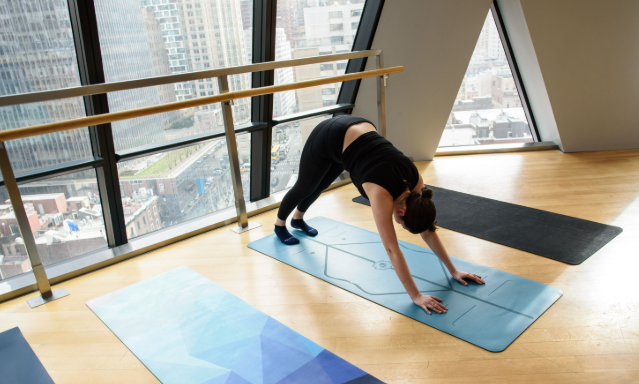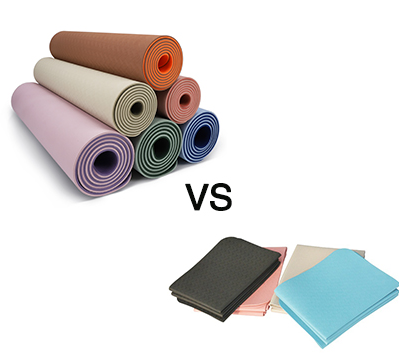If you’re looking to buy a yoga mat, I believe it’s helpful to understand the differences between traditional and foldable mats. A standard yoga mat gives you a non-slip surface. I find this surface great for many poses and it offers good cushioning. These mats are about 68 inches long and 1/4 inch thick. I’ve seen prices range from $20 to $100, which changes with the brand and material.

A foldable yoga mat, in my opinion, is all about being convenient and easy to carry. I like that you can pack these mats quickly or take them to different places. This makes them a great pick for yogis on the move or those who enjoy outdoor practice. Foldable mats are often about 1/8 inch thick, so they are a little thinner. This can mean less cushion, but it makes them very portable.
Comparing Features
- Portability: I find foldable yoga mats are lightweight. This makes them simple to move around.
- Thickness: In my experience, regular mats offer more cushioning. Foldable mats are often thinner.
- Material: Both mat types can come from earth-friendly materials. I recommend checking if they are non-toxic.
So, what’s the best choice for you? I think it really comes down to your personal needs. Do you value more cushioning and a steady mat, or is being easy to carry more important for you?
Regular or Foldable: Which Yoga Mat Should I Pick?
I recommend thinking about your lifestyle and your yoga routine. If you often go to classes or have a dedicated yoga space at home, a regular mat is probably your best bet. On the flip side, if you love doing yoga in new spots or are tight on space, I’d say a foldable yoga mat could be just what you need.
What Is a Regular Yoga Mat?
I find a regular yoga mat gives you a good non-slip surface. This is great for many yoga poses. In my experience, these mats provide enough cushioning. They are about 68 inches long and 1/4 inch thick. You can expect prices to be between $20 and $100. The brand and materials used will affect the price.

Key Features
Thickness: Most standard yoga mats are around 1/4 inch (about 6mm) thick, which I’ve found to provide excellent cushioning and joint support. This thickness strikes a great balance—it’s soft enough to protect your knees and elbows, yet firm enough to maintain stability during standing poses. For most yogis, it’s the sweet spot for everyday practice.
Material Options: Standard yoga mats come in a wide range of materials, including TPE (Thermoplastic Elastomer), PVC, natural rubber, and cork. Each material has its own benefits. For example, TPE is eco-friendlier and lightweight, while natural rubber offers excellent grip and durability. I think a key factor in choosing the material is not just comfort, but also how long the mat lasts and how eco-conscious you want your practice to be.
Storage: When it comes to storage, regular yoga mats are pretty convenient. They roll up easily, and most come with straps or carrying bags to make transport simpler. I’ve found this roll-up design ideal for home practice or when you’re heading to a nearby studio, though they can take up a bit of space in smaller storage areas.
Pros and Cons
Pros: I find regular yoga mats durable and supportive, especially for long-term use. The added thickness helps cushion your joints during more intense or floor-based poses. They also tend to lay flat better, providing a more stable surface for balance-focused asanas.
Cons: Their bulkiness can be a drawback if you’re someone who commutes often or travels with your mat. They’re not the easiest to pack in a suitcase or backpack, and that might limit how portable they are compared to foldable alternatives.
To sum it up, I recommend regular yoga mats if you practice at home or go to yoga classes. I believe they give you good comfort and stability for your practice.
What Is a Foldable Yoga Mat?
I find foldable yoga mats are made for convenience and portability. Unlike standard mats, you can fold these mats, which makes them simple to carry. I think they are great for yogis who travel or like practicing in various locations. From what I’ve seen, foldable mats are about 1/8 inch thick. This means they are thinner than regular mats. This might mean less padding, but I believe it makes them very portable.

Key Features
Portability: One of the biggest advantages of foldable yoga mats is their lightweight and travel-friendly design. I think they’re incredibly easy to carry, whether you’re heading to a yoga class, traveling for work, or practicing outdoors in a park. Their compact size means you can fit them into most backpacks or suitcases without any hassle, making them a favorite for yogis on the go.
Thickness: From my experience, foldable mats are generally thinner than standard yoga mats, usually around 1-2mm thick. While this means they provide less cushioning for your joints, it also makes them much easier to fold and transport. I think this trade-off works well if your practice is more focused on balance and flexibility rather than high-impact poses.
Storage: What I really like about foldable mats is how easily they can be packed away when not in use. You can fold them into a compact square or rectangle, which is perfect for tight spaces like small closets, shelves, or even desk drawers. This makes them ideal if you live in a small apartment or need a secondary mat for travel or the office.
Pros and Cons
Pros: I find foldable yoga mats especially useful for travelers and those who prefer a light, portable mat. Their space-saving design is a major advantage, and I’d definitely recommend them to anyone with limited storage space or a busy, mobile lifestyle.
Cons: Since they are thinner, they naturally offer less padding and joint support. In my opinion, this may not be suitable if you practice daily, especially if you have sensitive knees or wrists. Over time, the lack of cushioning might affect comfort during longer sessions.
Key Differences Between the Two
I find that knowing the differences between regular and foldable yoga mats helps you choose the best one for your needs. Let’s explore what sets them apart.
Comparison of Features
| Feature | Regular Yoga Mat | Foldable Yoga Mat |
|---|---|---|
| Portability | Not easy to carry | Ultra-portable, fits in suitcase |
| Thickness | Thicker, better cushioning | Thinner, minimal padding |
| Storage | Rolled and requires strap/bag | Folds flat, compact storage |
| Best Use | Home, studio, everyday practice | Travel, hotel, outdoor sessions |
| Typical Material | TPE, rubber, cork | Lightweight TPE or rubber |
| Price | Can be more expensive, varies | Often mid-range or affordable |
Expert Opinion:
“Based on my experience, and informed by Dr. Chen’s decade of research with thousands of yogis, I see that the kind of mat practitioners choose often shows their lifestyle. She points out that regular mats provide excellent cushioning. I agree these create what she terms a ‘practice sanctuary.’ To me, they indicate a dedication to consistent practice and good joint care. Foldable mats, on the other hand, suit the modern yogi’s need for mobility. I think they’re great for being flexible and practicing yoga anywhere. It’s interesting, as Dr. Chen discovered, that yogis who use both types of mats develop stronger and more versatile practices. I believe this is more beneficial than sticking to just one style.“
———— Dr. Sarah Chen , Certified Yoga Therapist and Movement Science Researcher at Wellness Institute
User Experience
From my experience, regular mats offer more cushioning. This extra padding is really helpful for protecting your joints during your everyday practice at home or in a studio. I believe this makes a big difference for overall comfort.
On the other hand, I think foldable mats are excellent if you are a yogi who travels often. You can easily practice in various locations with them. I suggest you choose based on your lifestyle needs. This will help ensure your practice is comfortable and enjoyable.
How to Choose the Right One
I believe picking the right yoga mat is all about what you need and what you like. Here are some things I suggest you think about:
Choose a regular mat if:

I recommend a regular mat if you practice often at home or in a studio. Or if you feel you need more support and stability, this is a good choice from my experience.
If you like having better cushioning, I find regular mats are great. They usually have a thickness of 1/4 inch. This offers more comfort for your joints, which I really appreciate.
If you’re looking for something that will last, I suggest a regular mat. Prices range from $20 to $100. This changes based on the brand and the material, like TPE or natural rubber. In my experience, natural rubber mats are very durable.
Choose a foldable mat if:

I suggest a foldable mat if you travel a lot. You’ll want something light and easy to carry.
Perhaps you want a backup mat for when you’re on the move. Foldable mats are very portable and I find they can fit in tight spaces easily.
If you like to practice in different places, a foldable mat is less bulky than a standard one. This makes it easier to take with you, in my opinion.
You might be okay with less cushioning. Foldable mats are often about 1/8 inch thick. This means they provide minimal padding, so I’d consider this if cushion isn’t your top priority.
Consider dual options:
I know some yogis, myself included, who invest in both types of mats. I think this offers great flexibility and convenience. This way, you can enjoy the comfort of your regular mat at home. Then, you’ll have the easy-to-carry foldable mat for travel or outdoor yoga sessions. I find this setup works perfectly.
Summary
Deciding between a regular and a foldable yoga mat? I think it comes down to what you need and like. For portability, foldable mats are fantastic. I recommend them if you travel or do yoga in different places. These mats are light. They pack down small. This is a big plus for outdoor yoga or taking to class, in my experience, as you can easily slip it into a bag. Regular yoga mats, on the other hand, give you more cushioning and stability. They are often about 1/4 inch thick. This extra thickness supports your joints better. I find this ideal for practicing at home or in a studio where you don’t need to move the mat often.

Pricing
Regular mats can cost anywhere from $20 to $100. The price changes based on the brand. The materials, like TPE or natural rubber, also affect the cost; I’ve found rubber mats can sometimes be at the higher end but offer great grip. I’ve noticed foldable mats are often a bit cheaper. They usually fit into the mid-range price category.
User Experience
Both kinds of mats offer something special for your yoga practice, from my perspective. Regular mats feel more comfortable because they have extra cushioning. I think this is really important for protecting your joints, especially if you do yoga often or like poses that put pressure on your knees and wrists. On the other side, foldable mats are super convenient. You can take them anywhere. This means you have more freedom. For example, you could practice in a park, on vacation, or even at the office. I find this great for a flexible yoga schedule.
Making Your Choice
To help you choose, I suggest you think about your lifestyle. Also consider your yoga routine. Do you practice daily, or just occasionally? Do you have a dedicated yoga space, or do you need to set up and pack away each time? If support and stability are most important to you, I believe a regular mat is your best bet. But, if you care more about convenience and saving space, I think a foldable mat will work well for you.
I don’t think there’s one perfect answer. Both mat types are good for different things. I encourage you to reflect on your practice style. Think about your routine. And consider your lifestyle. For example, someone who mostly practices gentle Hatha at home might prefer a regular mat, while a Vinyasa enthusiast who visits different studios might love a foldable one.
If you want a custom yoga mat, either regular or foldable, I suggest looking at FDM Yoga. They make mats with earth-friendly materials. They also offer OEM/ODM services. Plus, their minimum orders are flexible, which is good if you’re starting out or need a smaller batch.


